By Jennie L. Ilustre
Asian Americans only form 5 per cent of the total U.S. 300 million population, but over the years, their Spending Power continues to soar, and is projected to reach $1 trillion by 2017.
 This steady, rising consumer power was the subject of the latest report by Nielsen, top provider of information and insights into what consumers watch and buy.
This steady, rising consumer power was the subject of the latest report by Nielsen, top provider of information and insights into what consumers watch and buy.
The study noted, “Asian Americans are the fastest-growing multicultural group in the U.S. and are 54 per cent more likely than overall U.S. households to have incomes of $100,000.00 or more.
“Asian American consumers are a powerful economic and influential force,” remarked Betty Lo, Nielsen vice president of public affairs. She noted that over the years, they have been building on their heritage, academic achievement, adaptability and rising spending clout.
Remarked Karen Narasaki, Nielsen Asian Pacific American External Advisory Council Co-Chair: “We applaud Nielsen’s commitment to helping corporations understand the economic clout Asian Americans have as consumers and trendsetters.”
Virginia Delegate Mark Keam underscored one of the reasons Asian Americans “should get more involved” in making a difference in the political scene and Corporate America at the annual conference of the International Leadership Foundation: “Asian American Buying Power.”
To be sure, Buying Power can also be translated to Boycott Power, aimed at manufacturers, TV commentators (remember Rush Limbaugh mocking Chinese language?), movies and TV shows (ABC-TV’s “Desperate Housewives” episode mentioning fake Asian diplomas) that are culturally insensitive.
Recently, Asian American advocates in the nation’s capital have resorted to boycott, along with opening channels for dialogues, as tools in their continuing fight against racial stereotypes.
Highlights of the latest Nielsen report follow:
•Asian Americans spend 33 percent of their dollars on deals, compared to 27 percent of non-Asians. Nearly eight in ten say they like to shop around before making a purchase, and two-thirds say they are willing to pay more for quality.
•Close to ninety per cent of Asian American households have some sort of savings account, compared to 76 percent of the general U.S. population.
In addition, nearly one-third of Asian Americans surveyed keep money in certificate of deposits, a rate 86 percent higher compared to 17 percent of the general U.S. population.
•Ads featuring culturally relevant situations and characters make up 65 percent of top ads among Asian Americans.
•While Asians Americans are known to be tech savvy, many still use traditional media outlets such as TV, radio and print to get culturally-relevant entertainment and information.
Nielsen’s “Significant, Sophisticated and Savvy: The Asian American Consumer 2013 Report,” provides an in-depth look into the purchasing and viewing habits, as well as lifestyle trends of Asian Americans. It is part of Nielsen’s Diverse Intelligence Insights Series. To download a copy of the full report, please visit www.nielsen.com.
In related data, Shelby Report in 2010 listed the ten states with the largest Asian consumer markets as follows: “California ($172 billion), New York ($54 billion), Texas ($34 billion), New Jersey ($34 billion), Illinois ($24 billion), Hawaii ($23 billion), Washington ($18 billion), Florida ($75 billion, Virginia ($17 billion), and Massachusetts ($14 billion)…At $544 billion in 2010, the U.S. Asian market already outshines the entire economies of all but 23 countries.”
Not News Anymore
The latest Nielsen report is not news to McLean Mortgage Corporation Vice President Ramon M. Llamas. In an email interview, he said: “Nielsen’s survey results bears out what we typically know about Asians compared to other race groups: that they are highly educated, have the lowest unemployment rate, have highest incomes, and live in the priciest homes.
Llamas, senior mortgage loan officer with 20 years of bank lending experience, noted that the Spending Power trends are likely to continue “because Asians place a strong value on education, which is the best ticket to material success.” He cited a study that showed 50 per cent of Asian Americans 25 years and older have a Bachelor’s degree, compared to 28 percent of the total population.
 Asian Fortune Your source for all things Asian American
Asian Fortune Your source for all things Asian American



